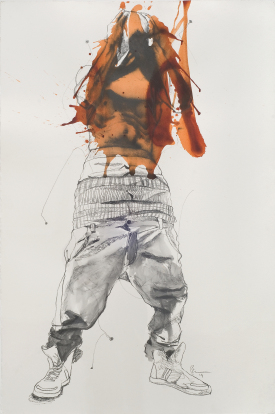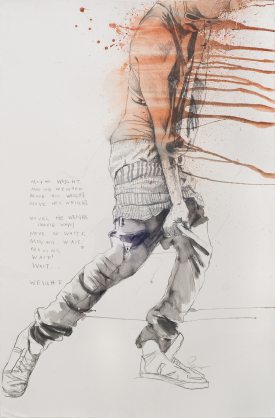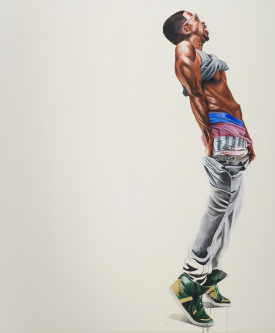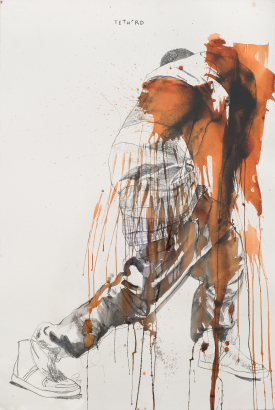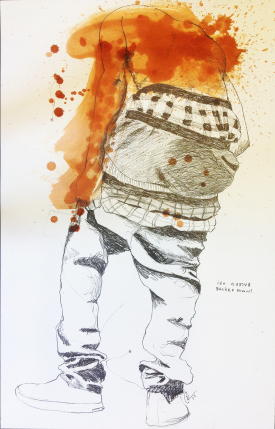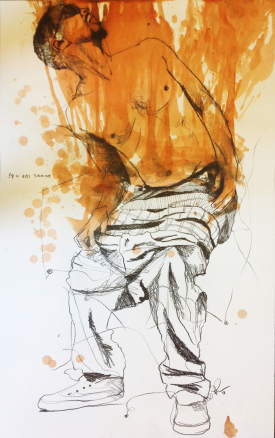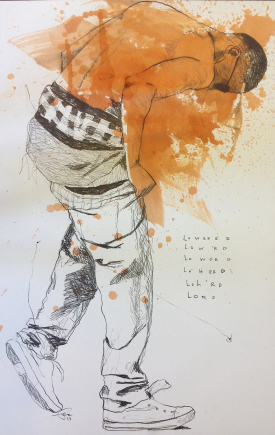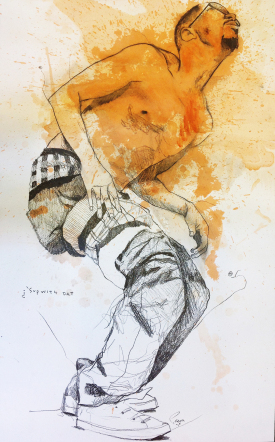Fahamu Pecou
by Ruth Rambo
Time for reflection and (re)imagination has arrived suddenly, involuntarily, and unexpectedly on the wings of our pandemic-plague. Dr. Fahamu Pecou, a multicultural, multigenreational artist arrives in time to help fill and direct that void by inspiring inquiry. Born in Brooklyn, Pecou uses a variety of artistic strategies to tell his story, including but not limited to acrylic on canvas, graphic design, installation art, videography, performance art, and music.
Pecou’s contribution to Dis/placements: Revisitations of Home is drawn from his series grav•i•ty (2013–14). Then and now, the artist speaks to the chronically troubling circumstance of the Black male in America. He uses the term gravity as a double entendre. It refers to both the physical concept of gravity—as in the force that presses matter toward the Earth—and the notion of something being grave and serious.
The works presented here are provocative and incendiary. They provoke even the artist to raise questions about their intention and purpose. Where is home when one is kidnapped from his ancestral home? Is it the cargo bottom of a slave ship? Is home the slave “dwelling” he occupies with his temporary family? Is it the tenant farming cabin? In the city, is it urban project housing?
The artist suggests that the Black male in America is at home only inside of his own skin and that his body is his house and his home, and the only thing that Black men are allowed to own in this country. Dr. Pecou shows us twelve disturbing images of these “homes,” representing Black masculinity in the United States.
While there is great synergy between the artist’s vision of his series and this viewer’s, the lens through which I view it is more than two generations and a gender apart. Why do I see the work as disquieting? Notice some of the powerful similarities among these pieces. The frames of these homes/bodies—bare, lean, and with muscular backs—are always bent. Atmospheric Pressure (2014) not only confirms the bent back emblematic of carrying heavy burdens, it also shows a bowed and hands-protected head. It suggests that the external forces of life require postures of submission and self-protection at all times. What kind of home is that? Isn’t home supposed to be a place of comfort where you are expected and embraced?
There is another iconographic similarity among the paintings—sagging—the lowered pant waists revealing layers of undergarments. These home/bodies show at least three layers of lower body coverings. The top layer seems to deliver serious mobility restraints. In the era of open floor plans, this home seems to be restricted. In Black Boy Fly (2014) the body is ascending while clutching his crotch, knees slightly bent, perhaps going for a basketball layup. Could it be that in the bent-knee posture of these home/bodies there are suggestions of humility, subservience, prayer? Pecou sees this particular clothing and posture as evidence of resistance efforts.
Then, in some of the pieces, the skin color extends past the drawn limits of the body or the home. Does it mean that their environment or neighborhood is reflective of the color of the house/body? Could it be that when you are a person of color all the environment sees is the color, not the person? And what of the sunglasses? Are they worn to protect the Black man from the glaring sun or to protect the outsider from seeing into his Black soul? What does it mean that the high-top sneakers are never laced? Is it a symbol of incompleteness and unfinished business? Or is it disregard for societal norms and expectations?
Pecou’s images raise many questions, answering few. For an excellent use of the time this venomous disease has given us, view, then review the work and consider the questions it enflames in you.
This series is provocative and stimulating and contemporary. It is of our time. It is for our time.
Fahamu Pecou
Born in Brooklyn, New York (1975)
Lives and works in Atlanta, Georgia
Dr. Fahamu Pecou is an interdisciplinary artist and scholar whose work combines observations on hip-hop, fine art, and popular culture. Pecou’s work seeks to provide a crucial intervention in contemporary representations of Black masculinity. He earned his BFA at the Atlanta College of Art in 1997 and a Ph.D. from Emory University in 2018.
Pecou’s work is featured in many collections including that of Smithsonian National Museum of African American Art and Culture, Washington, D.C.; Societe Generale, Paris, France; Nasher Museum at Duke University, Durham, NC; Crystal Bridges Museum of American Art, Bentonville, AR; Seattle Art Museum, Seattle, WA; and The High Museum of Art, Clark Atlanta University Art Collection, and Museum of Contemporary Art of Georgia, all in Atlanta, GA. Pecou is the recipient of many awards and grants including the Artadia Award (2009), Working Artist Fellowship from the Museum of Contemporary Art Georgia (2013), and the Joan Mitchell Foundation Painters & Sculptors Award (2016). He was recently named the inaugural Artist-in-Residence for the Atlanta Beltline (2020).
Fahamu Pecou’s work was featured at the Halsey Institute in 2016 in DO or DIE: Affect, Ritual, Resistance. The catalogue Fahamu Pecou: Visible Man was published by the Halsey Institute in 2017.
Ruth Rambo
A native of Cincinnati, Ohio, Ruth Rambo has dedicated her life to serving young adults, seniors, and minorities. Renowned for her work with groups, training program design, start-up management and implementation, Rambo has worked around the country in all aspects of social and community service organizations including the National Urban League, the Urban Coalition, The Massachusetts Employment and Training Programs, and the NFL Players Association.
A graduate of Fisk University in Nashville, Rambo earned her Master’s degree at LSU in the early 1960s as one of very few African American graduate students. Later she was awarded a fellowship to do graduate work in Urban Planning at MIT.
Rambo is now retired from AARP. In her free time, she reads, is a published poet/literary critic, tells African folktales, and co-wrote the lyrics with her nephew for her sorority’s centennial celebration song. While working for AARP, she served as a volunteer docent with the Smithsonian Institution’s National Museum of African Art and the National Museum of American History featuring National Museum of African American History and Culture exhibitions. Currently, Rambo serves as a tour guide and Advisory Board member with The Halsey Institute of Contemporary Art.
Boasting that she has appeared on stage as a background choir singer with both Al Green and Patti Austin, Rambo joined the Charleston Symphony Orchestra’s Spiritual Ensemble, currently on hiatus. She is an active member of the Poetry Society of SC, the century-old Phillis Wheatley Literary and Social Club, and the Association for the Study of African American Life and History.



